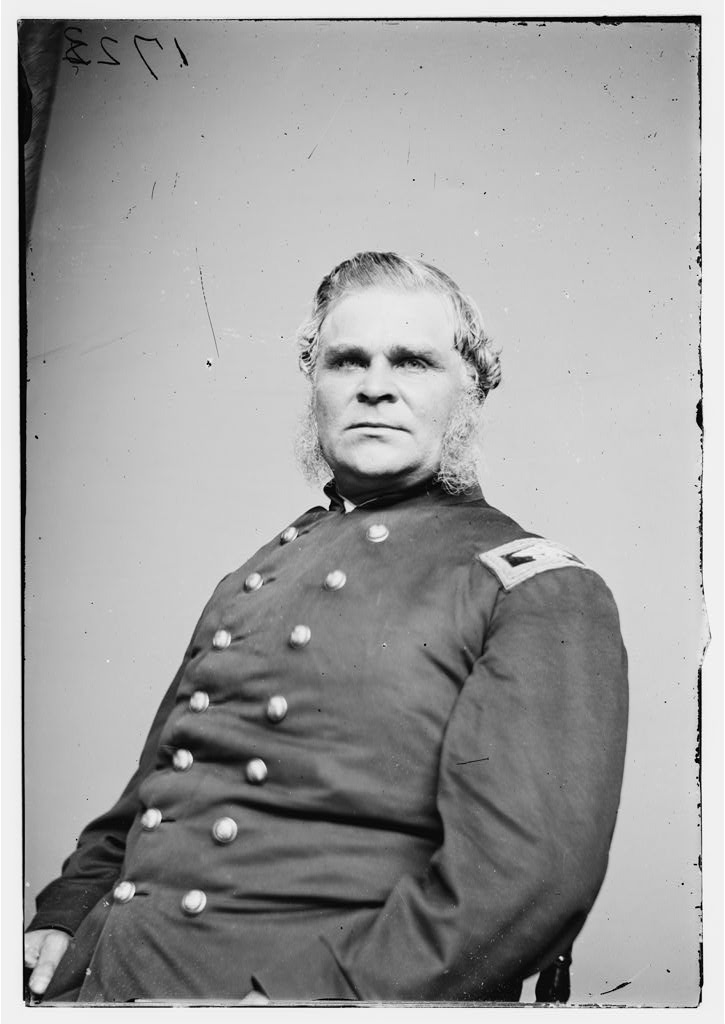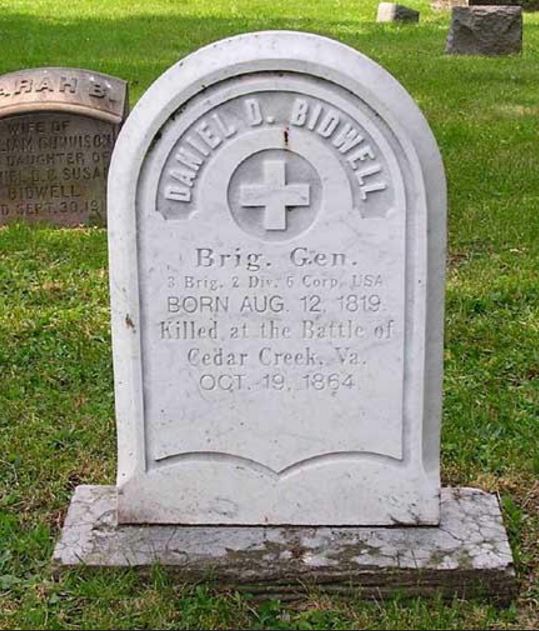“On Many a Bloody Field”: The Forgotten Story of Daniel Davidson Bidwell
Today, we are pleased to welcome back guest author Kevin Pawlak

When I first became interested in the American Civil War at the age of 9, I was living in a small town in western New York sandwiched halfway between Buffalo and Rochester. I lived there under the false impression that in order to find Civil War history, I had to visit the battlefields across the Eastern, Western, and Trans-Mississippi theaters. Now transplanted to the eastern panhandle of West Virginia and working in the heart of Mosby’s Confederacy, I have come to realize that my nine-year-old self could not have been further from the truth. Civil War history can be found almost anywhere you look, even if its miles away from the nearest battlefield. Go figure, as soon as I moved to West Virginia, I began discovering scores of stories regarding soldiers and civilians from western New York who played a role in the Civil War. One such story is that of Union general Daniel D. Bidwell.
Daniel Davidson Bidwell was born August 12, 1819 in Buffalo, New York. Initially slated to study law, Bidwell found more of a liking as a merchant. However, the bar continually called him back and the young Bidwell found himself working for the firm of his father and brother. Bidwell was elected as Buffalo’s Justice of the Peace and, several years later, the city’s residents voted him in as the Police Justice. Daniel proved to be a likeable magistrate, “stern and austere when occasion needed, but always with a hidden kindness looking out of the kindly eyes.” Perhaps Bidwell’s sternness and austerity suited him for well for his other calling in life, that of a military man, something that he endeared since his early childhood.
Bidwell joined the state militia as a private despite his high civilian rank. However, he eventually rose to command the company, which he organized independently before incorporating his company into the 74th Regiment of the New York State National Guard. Soon, Bidwell was offered command of the regiment but turned it down. A Buffalo newspaperman recalled years later that “the company into which he had drawn the best young manhood of Buffalo had grown into his life and become a part of himself. It was his pride, his pet—his military family, which he loved with father-like affection.” Bidwell took his position in the militia seriously, not as if it was an amateur gathering of armed men.
When the Civil War commenced, Daniel Bidwell became colonel of the 49th New York Infantry in the summer of 1861. Bidwell’s soldiers learned quickly that he led by example: “He never hesitated to expose himself to more than the dangers of his regiment, in order to exhibit an inspiring example. His face was as calm, his bearing as cool, his mind as composed, his voice as steady, when he rode along the line through a storm of plunging shells or whistling bullets as it used to be when he led some harmless holiday parade.” This composure on the field of battle and the example he set for the soldiers under him greatly endeared the men of the 49th New York to their colonel.
Daniel Bidwell led his regiment through the war’s early campaigns and by May 1863 had risen to command (in an on and off manner) the 3rd Brigade, 2nd Division, 6th Corps. His first full action as brigade commander came during the Battle of the Wilderness. There, on May 6, 1864, during the Confederate assault on the Army of the Potomac’s right flank, Bidwell’s brigade stopped the thus far successful Southern onslaught. “His was the form, on that portentous evening, that sat, among the bullets, upon his horse, in the language of General [John] Sedgwick, ‘like a man of iron,’ coolly directing the movements which repulsed the enemy, gave us back the field and saved the whole Army of the Potomac from disaster,” wrote a newspaper correspondent who witnessed the scene. The account may be slightly exaggerated, but Bidwell’s importance in stopping the attack and his bravery during the fight are two well illustrated and oft repeated statements.
Throughout the spring and summer of 1864, Bidwell continued to lead his brigade. He next appears at another critical juncture in the war when Confederate forces under Jubal Early approached the gates of Washington. During the fighting at Fort Stevens on July 12, 1864, Bidwell’s brigade assaulted Early’s force, driving it back away from the fort. In the brigade, all of Bidwell’s five regimental officers were casualties of the fight and his brigade of roughly 1,000 men suffered 35.8% casualties.
Daniel Bidwell and the men under his command seemed to have a knack for being placed in crucial positions throughout the bloody battles of 1864. October 19, 1864 proved to be no exception. As the sun rose on that autumn morning, Confederate forces—again under Early—attacked, surprised, and routed elements of Philip Sheridan’s Army of the Shenandoah camped north of Cedar Creek. As Sheridan’s army folded underneath the punishing attacks, the Federal 6th Corps moved forward to stymie the onslaught. Two divisions advanced into the fight while George Getty’s 2nd Division, including Bidwell’s brigade, fell into their rear as support and to hold the high ground where sat the Middletown Cemetery. Bidwell’s brigade held the left flank of Getty’s formation.

At 8 a.m., the first of what turned out to be three separate Confederate attacks against Getty’s position began. The 6th Corps soldiers “cooly [sic] held their fire until the enemy was close upon them, then delivered it in their very faces, and tumbled the shattered ranks down the hill….” As the rebels reformed for another push, they brought up artillery that began to hammer the Federal position. The Confederates doggedly came on again and again, finally forcing Bidwell’s brigade and the Vermonters to their right to slowly give up their ground one backward step at a time.
During the fight atop the hill, “General Bidwell sat erect on his horse, a few paces behind his prostrate brigade, as cool as though the storm of fire and death was not playing around him,” noted an admirer. As Bidwell’s men slowly began to give ground to their enemy, Bidwell and the officers of his brigade “at once restored the courage of the men, and they gave and took without further flinching, though the struggle was deadly.” Suddenly, a shell exploded amidst Bidwell’s troops and as Bidwell looked in that direction to see its effect, another shell “tore through his shoulders and lungs, bringing him heavily to the ground” in a state of unconsciousness. Bidwell let out one groan while his horse “stood still, as though it had not felt the emptying of its saddle.”
Apparently, the physically imposing Bidwell had gained consciousness when a surgeon came up to the prostrate man. “Doctor, I suppose there is no hope for recovery,” he said. The surgeon could not lie, knowing the wound to be mortal. “Oh, my poor wife,” Bidwell cried. Then, summoning strength, Bidwell told the surgeon, “Doctor, see that my record is right at home. Tell them I died at my post doing my duty.” Daniel Davidson Bidwell died several hours later after enduring “intense suffering,” according to the surgeon.
Getty’s division and Bidwell’s brigade were finally forced from their positions following a thirty-minute artillery bombardment from approximately 20 Confederate guns. Including their fallen general, Bidwell’s brigade lost 37 men killed, 172 wounded, and 16 captured or missing for a total of 225 casualties. George Getty’s stand had been instrumental in slowing the Confederate attack and proved key to the Union victory at Cedar Creek. Bidwell’s death did not help Getty’s division in any way, with one historian of the battle going so far as to say that “Bidwell’s death at a critical moment threatened to change the outcome of the Battle of Cedar Creek.” Getty’s and Bidwell’s and Sheridan’s men prevailed however and the telegraph dispatches sent to Buffalo “laden with victory to our arms…also brought the sad intelligence” of Bidwell’s death.
Daniel Bidwell’s remains were conveyed back to Buffalo five days after his death. The city’s mayor William George Fargo set the City Council room aside so that Bidwell’s remains could lie in state until his funeral. In a memorial to the City Council, Fargo wrote these fitting words about Bidwell:
Among the names of Buffalonians rendered historic by the war, none will occupy a higher place on the scroll of fame than the late General Bidwell. Leaving an important position of civil trust to do battle for the cause of the Union, devotedly and unostentatiously discharging his duty on many a bloody field, loved by his soldiers and commanding the confidence of his superior officers, promoted from the rank of colonel to that of general for gallant conduct, he has at last sealed his devotion to his country with his life. As a citizen he had won the regard of the community by his amiability and his correct deportment; as a soldier, he has given proof of these qualities of mind and heart, that unfaltering courage and iron will, which entitle him to the highest honors that a grateful and sorrowing people can bestow. It is becoming that the municipal government should testify to its respect for the memory of one who has died that the Nation may live.
Fargo may have spoken words that became more true than even he might have imagined. Bidwell Place in Buffalo bears a monument of the general atop a horse while three monuments to the general—including his gravestone—sit in Forest Lawn Cemetery where he rests. Before Bidwell died, his supposed last words were, “I have tried to do my duty.” In both civilian and military life, no one would have believed that Bidwell failed to do what his city and country always demanded of him. The next time I go home to western New York, I think you know where I will be visiting.

Thank you, Kevin, for a beautiful story of a fine Union soldier.
Thank you Kevin. Please plan on coming home in Oct. as there is always a ceremony at Forest Lawn .. The 49 NY reenactment unit keeps his memory alive .. There is also a parkway in Buffalo named after him.
On a side bar my 36 Virginia inf. unit Early Div. with out any planing would many times find it self across from the 49 NY at Ceder Creek . Sparking many conversations when we all got back to Buffalo .History does repeat it self. God Bless their memory.
One of the great yet overlooked defensive stands in the American Civil War there in the Middletown Cemetery. Great post and tribute to Bidwell.
I found this story unexpectedly. Thank you for writing, remembering this able and brave soldier.
Thank you for this fine tribute. Having done some work with the 49th NY and the brigade, I found Bidwell to be a solid and dependable leader of men, who did his duty to his community and his country to the fullest measure.
Another great article Kevin. As a native of the Buffalo area, I truly enjoyed your article. Many outstanding combat units came out of Western New York and it is great to hear accounts of the soldiers and the regiments and batteries that came from the area.
Thank you for this wonderful article. My husband and I are traveling to an Air Force reunion in Canada this September. We were Aware of the monument honoring General Bidwell through our family history.
Thank you for writing, remembering an able and brave soldier.